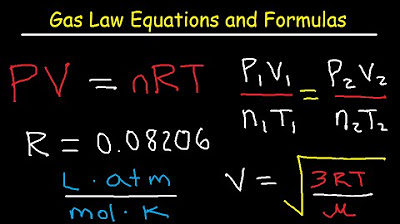Solving Chemistry Problems With Multiple Variables
TLDRThe video script introduces viewers to the concept of solving equations with two or more unknown variables, a common challenge in chemistry. It covers three distinct scenarios: coffee cup calorimetry, where the heat lost by a metal is equal to the heat gained by water, leading to a shared final temperature; gas laws, where the density of a gas like N2 at a given temperature and pressure is calculated using the ideal gas law and the molar mass of the gas; and Graham's law of effusion, which relates the rate of gas effusion to the molar mass of the gas. The script guides viewers through each problem, emphasizing the importance of understanding the underlying principles and applying them to find the solution. It encourages practice and further learning through provided resources.
Takeaways
- 🔍 When solving equations with two or more unknown variables, it's crucial to apply relevant concepts to find the relationship between them.
- 🧪 In chemistry, such as in coffee cup calorimetry, it's understood that two unknown variables (final temperatures of metal and water) will equal the same value due to heat exchange.
- ⚖️ The formula for heat (q) is mass times specific heat capacity times change in temperature (final minus initial temperature), and it's used to calculate the heat lost or gained.
- ♨️ The heat lost from the metal is equal to the heat gained by the water, and this relationship is represented with a negative sign in the formula.
- 🔢 For the coffee cup calorimetry example, you substitute known values into the formula and solve for the final temperature, combining final temperatures since they are equal.
- 📐 In gas law problems, you might need to find the density of a gas, which involves rearranging the ideal gas law formula and solving for moles divided by volume.
- 🌡️ To find the density, you use the molar mass of the gas (N2 in the example) and multiply it by the moles per liter to get the density in grams per liter.
- 📏 The units for density are grams per liter, and it's important to round the final answer to three significant figures.
- 🔬 Ratios are used to compare values in chemistry, such as in Graham's law of effusion, which relates the rate of effusion to the molar mass of gases.
- 💨 Graham's law helps to find the ratio of effusion rates between two gases, where the rate of one gas is compared to the other using their respective molar masses.
- ⚛️ Hydrogen gas (H2) and krypton gas are used as examples in the script to demonstrate how to calculate the ratio of their effusion rates using Graham's law.
- 📚 Practice is encouraged by working through related problems to solidify understanding of solving equations with multiple unknown variables in chemistry.
Q & A
What is the concept of coffee cup calorimetry?
-Coffee cup calorimetry is a concept where a metal at a high temperature is placed into water at a lower temperature. Over time, both the metal and water will reach the same final temperature due to the metal releasing heat and the water absorbing it.
What is the formula for calculating heat (q) in the context of calorimetry?
-The formula for calculating heat (q) is mass times specific heat capacity times the change in temperature, which is the final temperature minus the initial temperature.
How can you solve for the final temperature when dealing with two unknown variables in a calorimetry problem?
-You can solve for the final temperature by combining the final temperatures of the metal and water, since they will be the same. Plug in the given values for mass, specific heat capacity, and initial temperatures into the formula and solve for the final temperature.
What is the ideal gas law formula?
-The ideal gas law formula is pressure times volume equals moles times a known gas constant times temperature (PV = nRT).
How do you find the density of a gas like N2 at a given temperature and pressure?
-To find the density, you can rearrange the ideal gas law formula to solve for moles divided by volume. Then, use the molar mass of the gas to convert moles to grams, and the volume to convert volume to liters, resulting in the density in grams per liter.
What is the significance of the molar mass in calculating the density of a gas?
-The molar mass is significant because it allows you to convert the number of moles to grams, which is necessary to find the density of a gas in terms of mass per unit volume (grams per liter).
What is Graham's law of effusion and how does it relate to the molar mass of gases?
-Graham's law of effusion states that the rate of effusion of a gas is inversely proportional to the square root of its molar mass. It shows how the molar mass of a gas affects the rate at which it escapes from a container through a small opening.
How can you find the ratio of effusion rates between two different gases?
-You can find the ratio of effusion rates by using Graham's law formula, which compares the square root of the molar mass of one gas to the square root of the molar mass of another gas. The ratio is calculated by dividing the molar mass of the second gas by the molar mass of the first gas and taking the square root of the result.
What is the importance of understanding the concept that both final temperatures of the metal and water will be the same in a calorimetry problem?
-Understanding that both final temperatures will be the same allows you to combine the variables and simplify the equation, making it possible to solve for the final temperature with the given initial temperatures, masses, and specific heat capacities.
Why is it necessary to round the final density value to three significant figures?
-Rounding to three significant figures is necessary to maintain the precision of the measurement and to avoid implying a false level of accuracy. The number of significant figures is often limited by the least precise measurement in the calculation.
What is the role of the known gas constant (R) in the ideal gas law?
-The known gas constant (R) is a proportionality constant that relates the pressure, volume, and temperature of an ideal gas. It is used to calculate the amount of substance (in moles) when the volume and pressure of a gas are known.
How does the periodic table help in calculating the molar mass of elements or compounds?
-The periodic table provides the atomic mass of each element. To calculate the molar mass of a compound like N2, you multiply the atomic mass of nitrogen by the number of nitrogen atoms in the molecule (in this case, 2).
Outlines
🔍 Solving Equations with Multiple Variables: Calorimetry and Gas Laws
This paragraph introduces the concept of solving equations with two or more unknown variables, using the context of chemistry. It discusses how to handle situations where variables end up being equal due to physical processes, such as in coffee cup calorimetry. The video explains the formula for heat exchange between a metal and water reaching the same final temperature, using the formula q = mass × specific heat capacity × ΔT (final temperature - initial temperature). It then transitions to gas laws, specifically the ideal gas law, to find the density of N2 gas at given temperature and pressure. The summary includes rearranging the ideal gas law to solve for moles/volume and then using the molar mass to find density in grams/liters. The paragraph concludes with an introduction to Graham's law of effusion, which relates the rate of gas effusion to molar mass, without delving into the specifics.
📐 Applying Graham's Law of Effusion to Find Gas Ratios
The second paragraph delves into Graham's law of effusion, which is used to determine the ratio of effusion rates between two gases. It provides a formula for calculating this ratio, using the molar mass of the gases involved. The example given involves finding the ratio of effusion rates between hydrogen gas (H2) and krypton gas. The periodic table is referenced to find the molar masses of both gases, leading to the calculation of the ratio. The process involves dividing the molar masses, taking the square root of the result, and obtaining a ratio of 6.44. The paragraph encourages practice with the provided material and hints at further exploration of these concepts in subsequent videos.
Mindmap
Keywords
💡Unknown Variables
💡Calorimetry
💡Heat Transfer
💡Ideal Gas Law
💡Density
💡Molar Mass
💡Graham's Law of Effusion
💡Effusion
💡Ratio
💡Specific Heat Capacity
💡Thermochemistry
💡Significant Figures
Highlights
Solving equations with two or more unknown variables is the focus of the video.
In chemistry, sometimes two unknown variables can be recognized to equal the same value, as in coffee cup calorimetry.
The heat lost from an object is equal to the heat gained by another, with a specific formula involving mass, specific heat capacity, and temperature change.
The final temperatures of two substances in a calorimetry problem can be combined as they equalize.
The ideal gas law is used to solve for unknown variables in gas law problems, with a formula relating pressure, volume, moles, and temperature.
Density is calculated as mass divided by volume, which can be rearranged to solve for moles in gas law problems.
The molar mass of a gas can be used to find the density in grams per liter.
Graham's law of effusion relates the rate of gas effusion to the molar mass of the gas.
The ratio of effusion rates between two gases can be calculated using their molar masses.
Diatomic molecules, like hydrogen (H2), are considered in their molecular form when calculating molar mass.
The ratio of effusion rates is found by dividing the molar masses and taking the square root.
Practical applications of these concepts are demonstrated through examples like coffee cup calorimetry and gas law calculations.
The importance of understanding the underlying concepts in chemistry to solve problems with multiple unknown variables is emphasized.
Practicing with provided problems is encouraged to solidify understanding of the concepts.
The video provides a comprehensive guide to solving equations with multiple unknown variables in chemistry.
The use of the periodic table is crucial for finding molar masses of elements and compounds.
Significant figures are rounded to three in the final answer for precision and accuracy.
Transcripts
Browse More Related Video

Gas Laws - Equations and Formulas

9.3 Additional Gas Laws | Dalton's Law and Graham's Law | High School Chemistry

Ideal gas equation example 4 | Chemistry | Khan Academy

Passing Gases: Effusion, Diffusion, and the Velocity of a Gas - Crash Course Chemistry #16

Unit 4.5 - Stoichiometry

9.2 Gas Laws including the Ideal Gas Law | High School Chemistry
5.0 / 5 (0 votes)
Thanks for rating: